1993 PONTIAC GRAND-AM Fluids and lubricant
[x] Cancel search: Fluids and lubricantPage 4 of 306

How to Use this Manual
Using Your 1993 Pontiac
Owner’s Manual
Many people read their owner’s manual
from beginning to end when they first
receive their new vehicle. This will help
you learn about the features and controls
for your vehicle. In this manual, you’ll
find that pictures and words work
together to explain things quickly.
There are nine parts with color-tabbed
pages
in this manual. Each part begins
with a brief list of contents,
so you can
usually tell at a glance if that part
contains the information you want.
You can bend the manual slightly to
reveal the color tabs that help you find a
part.
Part 1: Seats & Safety Belts
This part tells you how to use your seats
and safety belts properly.
Part 2: Features & Controls
This part explains how to start and
operate your Pontiac.
Part 3: Comfort Controls & Audio
Systems
This part tells you how to adjust the
ventilation and comfort controls and
how to operate your audio system.
Part 4: Your Driving and the Road
Here you’ll find helpful information and
tips about the road and how to drive
under different conditions.
Part 5: Problems on the Road
This part tells you what to do if you
have a problem while driving, such as
a
flat tire or engine overheating. ’
Part 6: Service & Appearance Care
Here the manual tells you how to keep
your Pontiac running properly and
looking good.
Part 7: Maintenance Schedule
This part tells you when to perform
vehicle maintenance and what fluids and
lubricants
to use.
Part 8: Customer Assistance
Information
This part tells you how to contact
Pontiac for assistance and how to get
service publications. It also gives you
information on
Reporting Safety Defects.
Part 9: Index
Here’s an alphabetical listing of almost
every subject in this manual. You can
use
it to quickly find something you
want to read.
Service Station Information
This is a quick reference of service
information. You can find it
on the last
page
of this manual.
3
ProCarManuals.com
Page 198 of 306

Part 6
... N604
Here you will find information
about the care of your Pontiac
. This
part begins with service and fuel
information. and then it shows how
to check important fluid and
lubricant levels
. There is also
technical information about your
vehicle. and a section devoted to its
appearance care
.
Service & Appearance Care
Service ................ .................................. 198
Fuel
........................................................... 199
HoodRelease .................................................... 205
Engineoil
...................................................... 209
Aircleaner
...................................................... 214
Transaxle Fluid
.................................................. 216
Engine Coolant
.................................................. 221
Power Steering Fluid
.............................................. 224
Windshield Washer Fluid
........................................... 224
Brakes
......................................................... 225
Battery
......................................................... 227
BulbReplacement
................................................ 228
Windshield Wiper Blade Replacement
................................. 230
Loading Your Vehicle
............................................. 230
Tires
.......................................................... 232
Appearancecare
................................................. 239
Vehicle Identification Number (VIN)
................................. 247
Add-on Electrical Equipment
....................................... 248
Fuses
& Circuit Breakers ........................................... 248
Capacities
& Specifications ......................................... 251
Fluids
& Lubricants ............................................... 253
Replacement Bulbs
............................................... 254
Normal Maintenance Replacement
Parts ............................. 257
197
ProCarManuals.com
Page 205 of 306
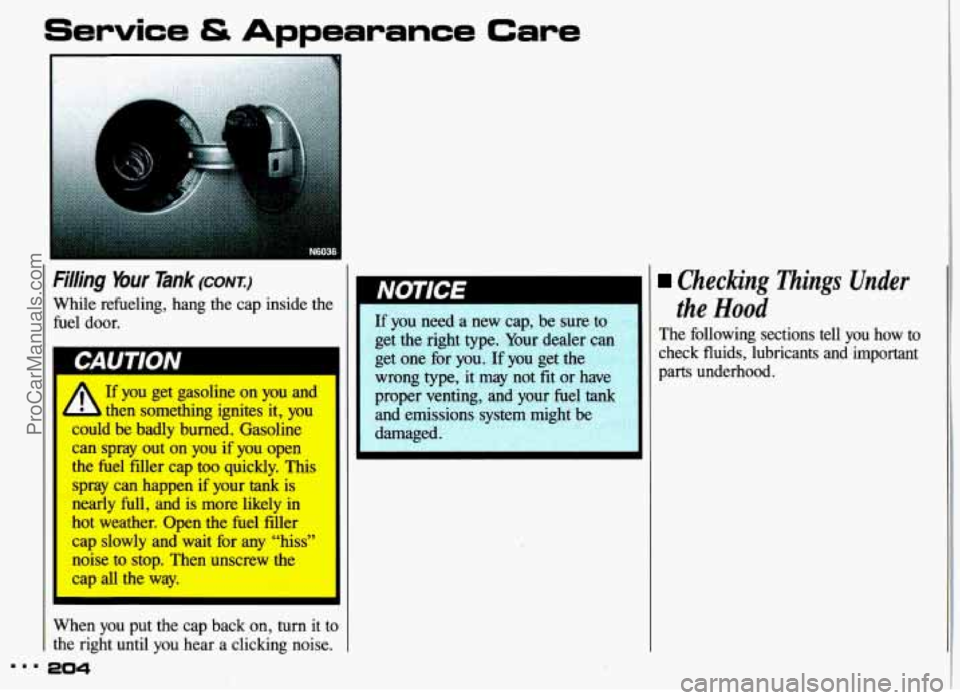
Service & Appearance Care
Filling Your Tank CON^)
While refueling, hang the cap inside the
fuel door.
A If you get gasoline on you and
- then something ignites it, you
could be badly burned. Gasoline
can spray out on you if you open
the fuel filler cap too quickly, This I
spray can happen if your tank is
nearly full, and is more likely in I
hot weather. Open the he1 filler
cap slowly and wait for any “hiss”
noise to stop. Then unscrew the
cap all the way.
When you put the cap back on, turn it to
the right until you hear a clicking noise.
204 ...
I’y ‘I ICIC
If you need a new cap, be sure to
get
the right type. Your dealer can , ,
get one for you. If you get the
wrong type, it may not fit or have
proper venting, and your fuel
tank
and emissions system might be
damaged. I
Checking Things Under
the Hood
The following sections tell you how to
check fluids, lubricants and important
parts underhood.
ProCarManuals.com
Page 221 of 306
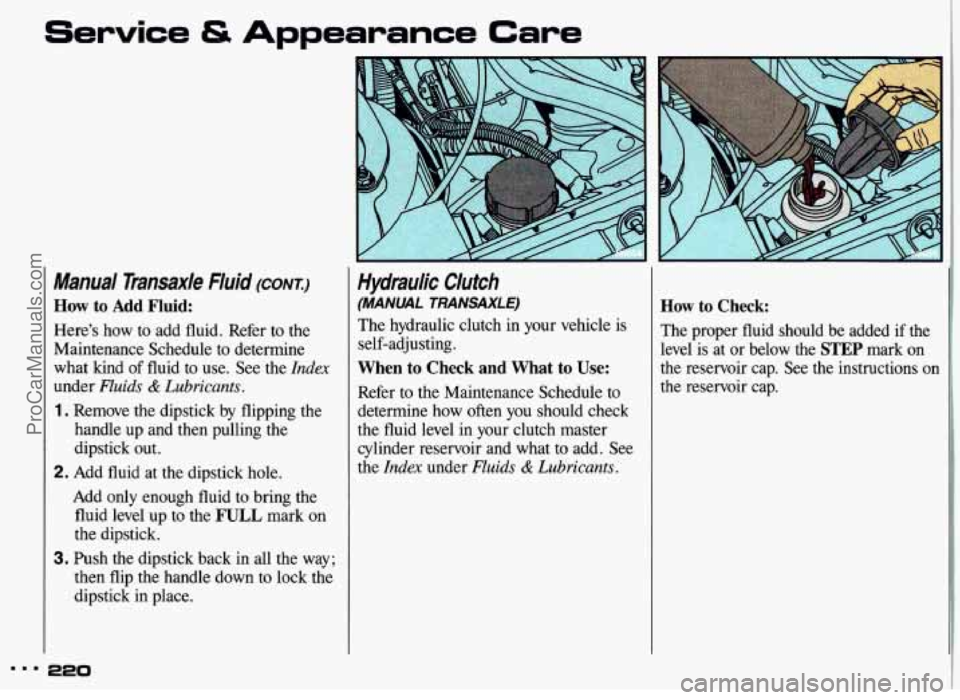
Service & Appearance Care
Manual Transaxle Fluid (CONI)
How to Add Fluid:
Here’s how to add fluid. Refer to the
Maintenance Schedule to determine
what kind
of fluid to use. See the Index
under Fluids & Lubricants.
1. Remove the dipstick by flipping the
handle up and then pulling the
dipstick out.
2. Add fluid at the dipstick hole.
Add
only enough fluid to bring the
fluid level up to the
FULL mark on
the dipstick.
3. Push the dipstick back in all the way;
then flip the handle down to lock the
dipstick in place.
220
Hydraulic Clutch
(MANUAL TRANSAXLE)
The hydraulic clutch in your vehicle is
self-adjusting.
When to Check and What to Use:
Refer to the Maintenance Schedule to
determine how often you should check
the fluid level in your clutch master cylinder reservoir and what to add. See
the
Index under Fluids & Lubricants.
How to Check:
The proper fluid should be added if the
level is at or below the
STEP mark on
the reservoir cap. See the instructions on
the reservoir cap.
ProCarManuals.com
Page 225 of 306
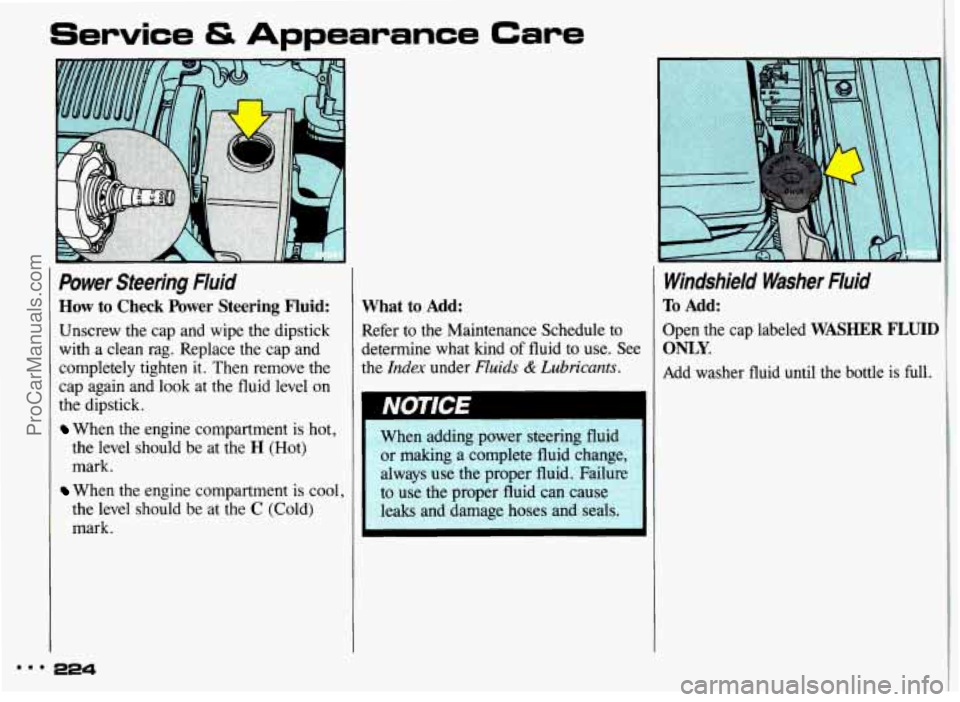
Service & Appearance Care
Power Steering Fluid
How to Check Power Steering Fluid:
Unscrew the cap and wipe the dipstick
with a clean rag. Replace the cap and
completely tighten
it. Then remove the
cap again and look at the fluid level
on
the dipstick.
When the engine compartment is hot,
the level should be at the
H (Hot)
mark.
the level should be at the
C (Cold)
mark.
When the engine compartment is cool,
What to Add:
Refer to the Maintenance Schedule to
determine what kind
of fluid to use. See
the
Index under Fluids & Lubricants.
Windshield Washer Fluid
To Add:
Open the cap labeled WASHER FLUID
ONLY.
Add washer fluid until the bottle is full.
mmm 224
ProCarManuals.com
Page 260 of 306
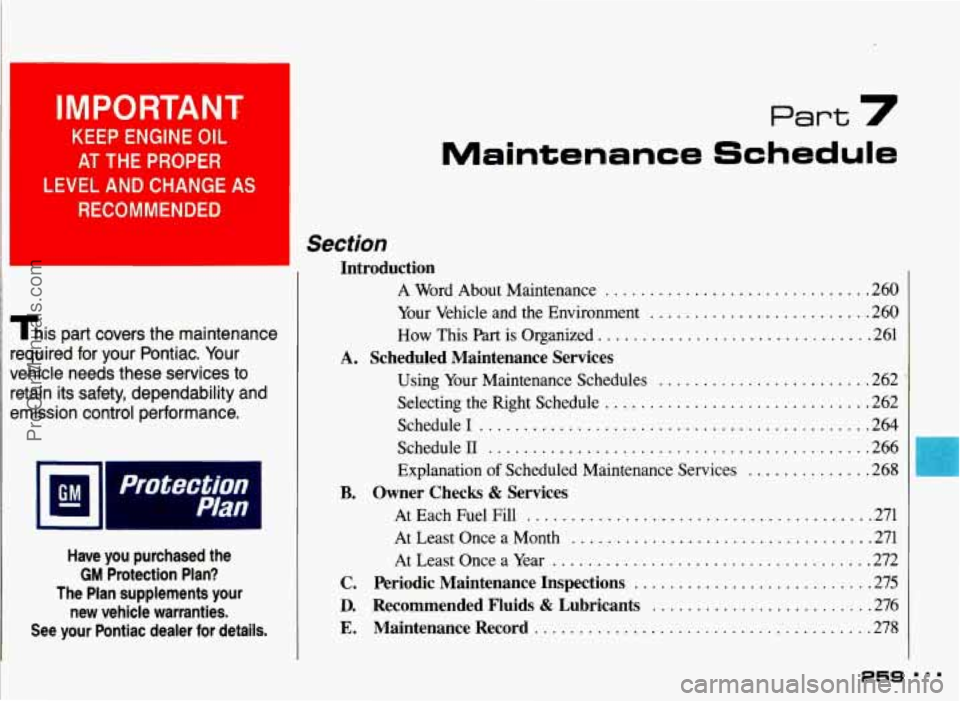
3 IMPORTANT
KEEP ENGINE OIL
AT THE PROPER
LEVEL AND CHANGE AS
RECOMMENDED
This part covers the maintenance
required for your Pontiac
. Your
vehicle needs these services to
retain its safety. dependability and
emission control performance
.
Section
Part 7
Maintenance Schedule
Have you purchased the
GM Protection Plan?
The Plan supplements your new vehicle warranties
.
See your Pontiac dealer for details .
Introduction
A Word About Maintenance ............................ 260
Your Vehicle and the Environment
......................... 260
How This Part is Organized ............................... 261
Using Your Maintenance Schedules
........................ 262
Selecting the Right Schedule
.............................. 262
Schedule1
............................................ 264
ScheduleII
......................................... 266
Explanation
of Scheduled Maintenance Services . . ... 268
A . Scheduled Maintenance Services
B . Owner Checks & Services
AtEachFuelFill ....................................... 271
At Least Once a Month
.................................. 271
At Least Once a Year
.................................... 272
C . Periodic Maintenance Inspections ........................... 275
D . Recommended Fluids & Lubricants ......................... 276
E . MaintenanceRecord ...................................... 278
259
ProCarManuals.com
Page 262 of 306
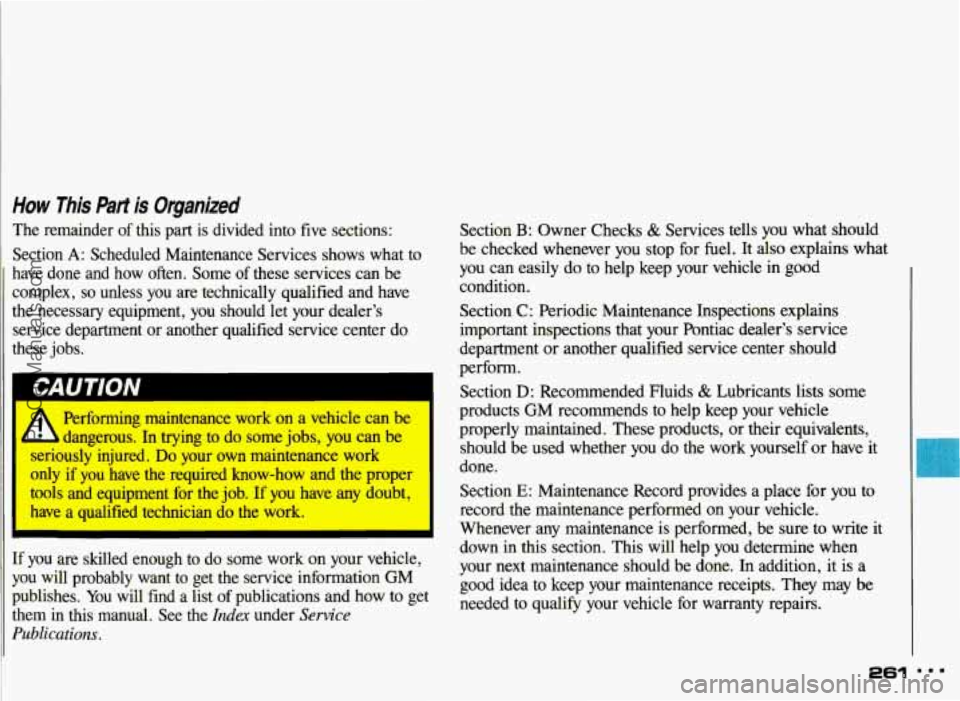
How This Part is Organized
The remainder of this part is divided into five sections:
Section
A: Scheduled Maintenance Services shows what to
have done and how often. Some of these services can be
complex,
so unless you are technically qualified and have
the necessary equipment, you should let your dealer's
service department or another qualified service center do
these jobs.
Performing maintenance work on a vehicle can be
3 dangerous. In trying to do some jobs, you can be
.-' wsly injured. Do your own maintenance work
UIUY if you have the required know-how and the proper
tools and equipment for the job. If
you have any doubt,
have a qualified technician do the work.
I
If you are skilled enough to do some work on your vehicle,
you will probably want to get the service information GM
publishes. You will find a list
of publications and how to get
them in this manual. See the
Index under Service
Publications.
Section B: Owner Checks & Services tells you what should
be checked whenever you stop for fuel. It
also explains what
you can easily do to help keep your vehicle in good
condition.
Section
C: Periodic Maintenance Inspections explains
important inspections that your Pontiac dealer's service
department or another qualified service center should
perform.
Section
D: Recommended Fluids & Lubricants lists some
products GM recommends to help keep your vehicle
properly maintained. These products, or their equivalents,
should be used whether you do the work yourself or have it
done.
Section
E: Maintenance Record provides a place for you to
record the maintenance performed on your vehicle.
Whenever any maintenance is performed, be sure to write it
down in this section. This will help you determine when
your next maintenance should be done. In addition, it is a
good idea to keep your maintenance receipts. They may
be
needed to qualify your vehicle for warranty repairs.
ProCarManuals.com
Page 269 of 306
![PONTIAC GRAND-AM 1993 Owners Manual Maintenance Schedule
Section A: Scheduled Maintenance Services [cant.]
Explanation of Scheduled Maintenance Services
Below are explanations of the services listed in Schedule I
and Sched PONTIAC GRAND-AM 1993 Owners Manual Maintenance Schedule
Section A: Scheduled Maintenance Services [cant.]
Explanation of Scheduled Maintenance Services
Below are explanations of the services listed in Schedule I
and Sched](/manual-img/50/58387/w960_58387-268.png)
Maintenance Schedule
Section A: Scheduled Maintenance Services [cant.]
Explanation of Scheduled Maintenance Services
Below are explanations of the services listed in Schedule I
and Schedule II.
The proper fluids and lubricants to use are listed in
Section D. Make sure whoever services your vehicle uses
ITEM
NO. SERVICE
1 Engine Oil and Filter Change-Always use SG
Energy Conserving 11 oils of proper viscosity.
The “SG” designation may be shown alone or
in
combination with others, such as “SG/CC,”
“SG/CD” or
“SF, SG, CC,” etc. If you have the
2.3L Quad OHC or a Quad
4 engine, the preferred
viscosity for your vehicle’s engine is
SAE 5W-30.
However, you can use
SAE 1OW-30 if it’s going to
be
0°F (-18°C) or above. If you have the 3300 V6
engine, the preferred viscosity for your vehicle’s
engine is
SAE 1OW-30. However, you can use SAE
5W-30 if it’s going to be 60°F (16°C) or below. these. All parts should be replaced and all necessary repairs
done before you or anyone else drives the vehicle.
NOTE: To determine your engine’s displacement and code,
see the
Index under Engine Identijication.
ITEM
NO.
2
3
4
SERVICE
Chassis Lubrication-Lubricate the transaxle shift
linkage, parking brake cable guides, underbody
contact points and linkage. Lubricate the front and
rear suspension, steering linkage and fuel filler
door and striker plunger.
Throttle
Body Mounting Bolt Torque (3300 V6
Code N engine)*-Check the torque of the
mounting bolts and/or nuts.
Tire and Wheel Rotation and Inspection-For
proper wear and maximum tire life, rotate your
tires following the instructions in this manual. See
the
Index under llres, Inspection & Rotation.
Check the tires for uneven wear or damage. If you
see irregular or premature wear, check the wheel
alignment. Check for damaged wheels
also.
* An Emission Control Service.
i? The US. Environmental Protection Agency has determined that the failure to pe@orm this maintenance item will not nullifL the emission warranty or
limit recall liability prior to the completion
of vehicle useful life. General Motors, however, urges that all recommended maintenance sem’ces be
peflormed at the indicated intervals and the maintenance be recorded in Section E: Maintenance Record.
268
ProCarManuals.com